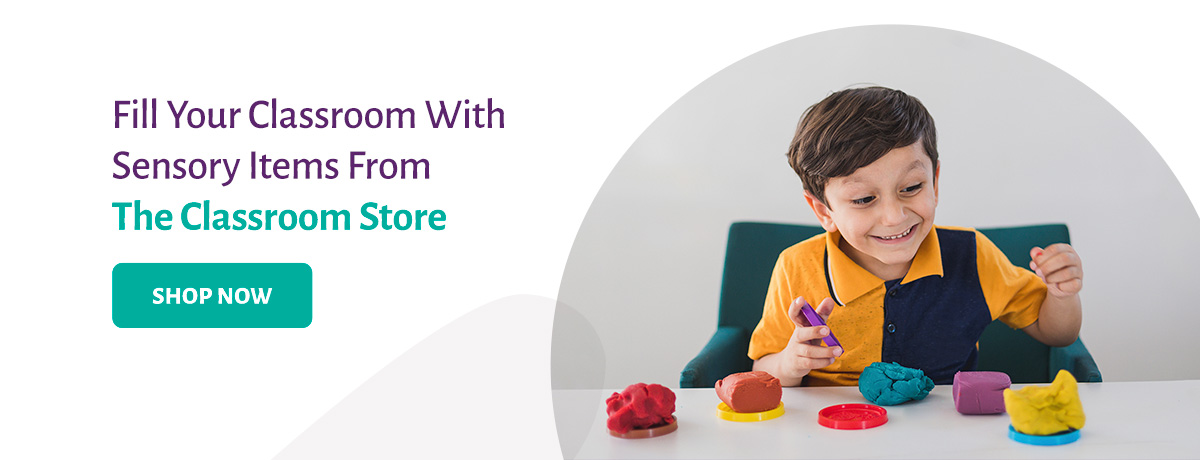10 Sensory Activities for Kids
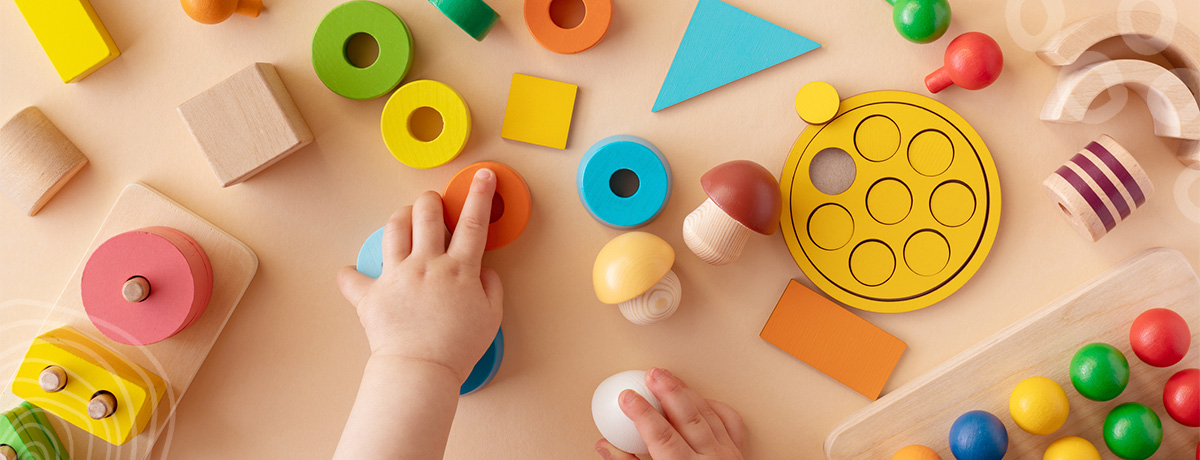
When you imagine how young kids learn in school, you probably think of memorizing numbers, using flashcards or singing the alphabet. While these are certainly effective ways for kids to learn in school, it’s important to provide children with fun sensory activities that engage their senses, promote creativity and enhance scientific thinking. Sensory play includes any activity that stimulates a child’s senses, including touch, taste, hearing, sight and smell.
Facilitating learning through sensory play encourages kids to be messy and investigate the world around them. However, many teachers like yourself may not know how to offer sensory play opportunities or how it benefits kids. In this guide, we’ll provide an overview of what sensory play is, how it improves learning and some sensory play ideas you can try in the classroom.
What Is Sensory Play?
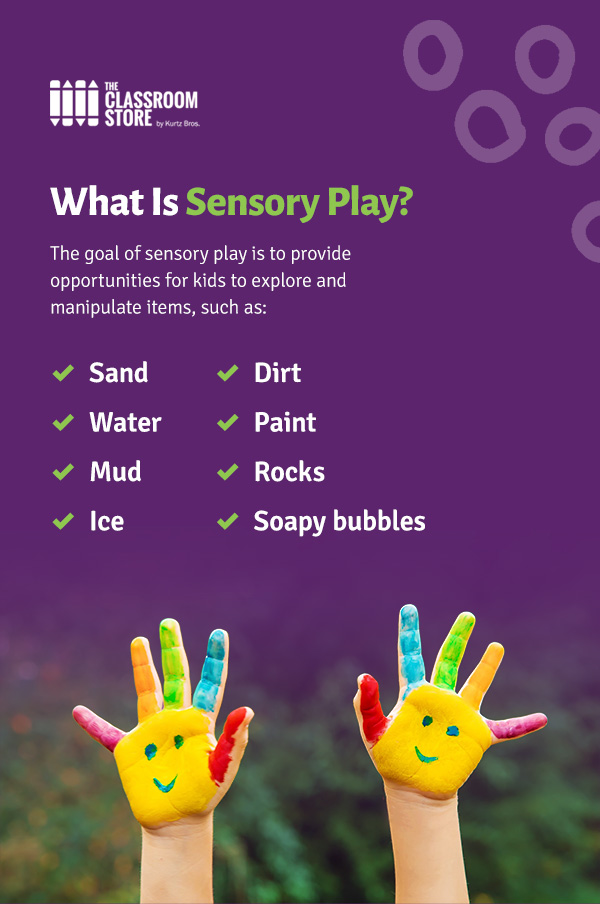
Have you ever noticed how young children seem to constantly need to touch things around them and put everything in their mouths? From playing with blocks and making messes with their food to getting paint all over themselves, kids always use objects around them to learn and develop. This is known as sensory play. Sensory play includes any activity where a child can play with materials and engage their senses. Stimulating these senses helps kids learn many physical, social-emotional, thinking and language skills.
While sensory play generally covers the five senses, it also extends to spatial awareness, balance and fine motor skills, such as using the muscles in their wrists, hands and fingers. This type of play promotes learning and development by allowing the child to interact with their environment and explore the sensory world. Unlike strict, structured play, sensory play enables children to explore and use natural scientific processes as they learn to create, discover and investigate new sensations and experiences.
The goal of sensory play is to provide opportunities for kids to explore and manipulate items, such as:
- Sand
- Water
- Mud
- Ice
- Dirt
- Paint
- Rocks
- Soapy bubbles
Playing with these materials builds a child’s understanding of their environment and helps them learn coordination and cognitive development. For instance, learning how to sort soft versus hard items or identifying certain sounds and textures through sensory activities is a simple and exciting way for kids to get hands-on experience in an unstructured setting. A child may play with soap and learn how the bubbles form when combined with water or that wet sand holds its shape while dry sand does not.
Through sensory play, kids practice many skills, including observation, prediction, drawing conclusions or using new words to express what they hear, see and feel. There are countless ways kids can engage in sensory play, both at home and in the classroom, but the most essential thing is that they get to explore their curiosity.
The Benefits of Sensory Play
Sensory play is more than fun and experimental for kids. These activities support them in many different ways by creating strong connections to sensory information. With simple materials and unstructured play, kids can refine their skills and better understand their world. Sensory play is an important part of childhood throughout many stages, from babies and toddlers to preschoolers and beyond. Let’s dive into the benefits of sensory play.
1. Social, Emotional, Language and Brain Development
Research shows that sensory play enhances nerve connections in the brain that help kids develop better skills, including memory and retention, oral language, communication and mindfulness. Through sensory play, children learn the foundation for completing more challenging tasks in the future. This hands-on, self-directed play also encourages different learning and thinking styles, which enables children to develop their knowledge.
While sensory play can be individual, it’s also helpful to promote these activities among small groups so that kids can play side by side. This enhances children’s ability to see situations from another kid’s perspective, consider their thoughts and feelings, and learn how to express their wishes. Ultimately, this can lead to more acceptance and inclusion as kids learn to play together and explore learning in a fun way.
2. Motor Skills
Motor skills are essential during a child’s developmental years because they help them learn how to use their muscles and engage their bodies in physical movements and activities. Sensory play strengthens fine motor skills by encouraging kids to use their fingers, hands, wrists, feet, lips and tongue in new ways. This could include molding play dough or wiggling their toes in a sensory bin full of sand.
3. Cognition
Because sensory play involves observation, sorting, patterns and manipulating new objects, these activities support cognitive development in children. These simple, fun experiences can help kids learn about science, math and many other critical skills, making it easier for them to expand their thought processes and accomplish more complex learning activities.
4. Spatial Awareness
Sensory activities for students promote fun learning while enhancing their awareness of their bodies and the world around them. Sensory play helps kids learn to be more mindful of themselves and how they touch things, carry items or engage in conversation with others. These skills can also help them on the playground, as sensory skills make it easier for them to grasp monkey bars or walk across a balance beam without falling.
5. Adaptability
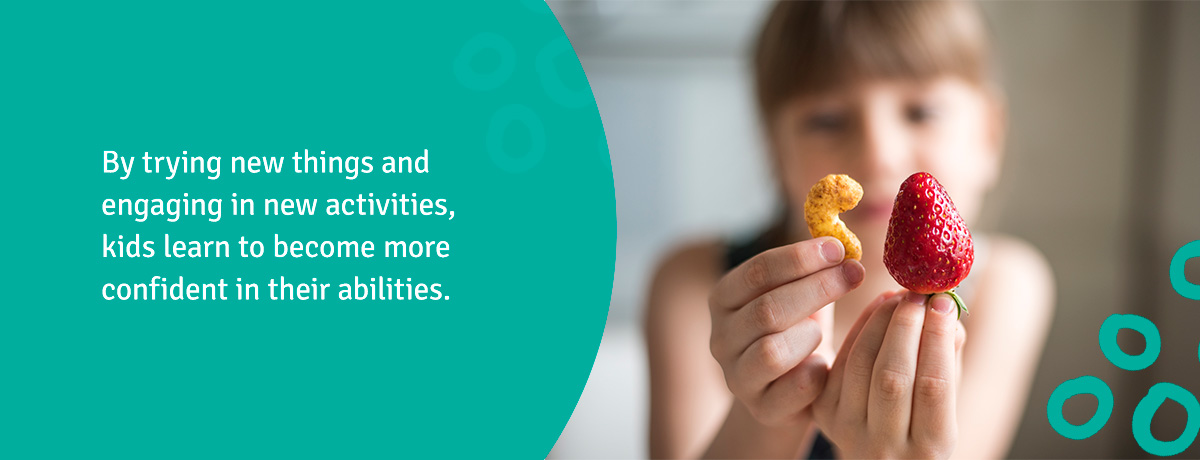
Sensory play introduces kids to a whole new world of experiences and materials. By trying new things and engaging in new activities, kids learn to become more confident in their abilities. This development can make them better able to adapt to new situations as they grow older. Through sensory play, kids learn that some challenges can be exciting, which also strengthens their resilience.
6. Creativity
Many types of free, unstructured play support imagination and creativity. Sensory play provides kids with exciting materials and gives them the freedom to choose how they want to manipulate and explore the objects. For instance, painting activities can encourage kids to visualize pictures they want to create. This type of play shows kids that the process is more important than the end result, allowing them to let their imagination run wild, ask questions and satisfy their curiosity.
7. Problem-Solving
Overcoming challenges and making decisions are key elements of problem-solving, which kids can practice through sensory play. With scientific experiments, children can predict what will happen and try new strategies to see how the results differ. Sensory play encourages experimentation and inquiry, which are essential for helping kids learn how to use their senses in open-ended activities.
8. Comfort
Last but certainly not least, sensory play can play a critical role in calming and soothing kids. In the same way that adults might use a stress ball or go for a run when they’re stressed, kids can knead kinetic sand, play with colored rice or run their fingers through water to feel comfort and other emotional benefits.
10 Sensory Activities for Kids
As you can see, sensory play is critical for many developmental aspects of a child’s life. Here are 10 sensory activities for elementary students you can try in your classroom.
1. Feeling Fabric
One of the easiest ways to expose kids to new textures is by giving them a variety of fabrics to touch. Place a bunch of old scraps of fabric in an empty wet wipe box or tissue container. Try to include as many colors and textures as you can, such as velvet, cotton or glittery material. Fold the scraps and overlap them like tissues so they pop up when kids pull on them.
Give the box to your students and encourage them to pull the fabric out and open and close the lid as much as they want. Have them feel the fabric in their hands or rub the soft material against their cheek so they can explore a new sensation. Remove the lid and place the fabric back inside to repeat the activity.
2. Food Exploration
Using a plastic activity tray or shallow sensory bin, let your students get messy with different types and textures of food. For this sensory activity, you can use baby food, dry pasta, corn meal, chocolate chips, cooked spaghetti or any other foods you think your students would like to play with. You can even use fruits and vegetables. This activity is great for exploring smell and texture, but it can certainly get messy, so be prepared for dirty hands and faces. It’s up to you whether you think the food is in good condition to eat afterward!
Allow your students to smear, smash, twist, scoop and play with the food however they want. This type of food exploration can help them understand more about the different foods they eat and allow their curious little hands to engage in a satisfying tactile activity.
3. Play Dough
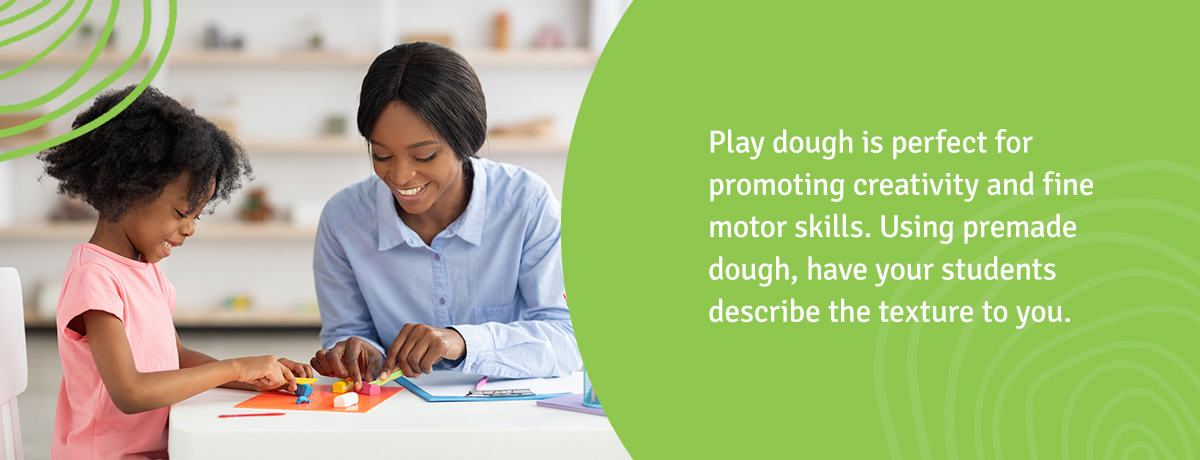
Soft play dough is enticing for many kids because it allows them to pull, squish, roll and manipulate the material into their desired shape. Play dough is perfect for promoting creativity and fine motor skills. Using premade dough, have your students describe the texture to you. Is it soft or squishy? What does it smell like? What kind of shapes can they make with it?
Give your students plastic tools, such as rolling pins and cookie cutters, so they can stretch out the dough and slice it into new shapes. To make things even more fun, you can add objects like toy cars, sensory blocks and other materials and instruct your students to cover the objects in play dough.
4. Sound Tubes
You can stimulate your students’ hearing and listening skills with these fun sound tubes. All you need are some empty toilet paper or paper towel rolls, duct tape and a variety of materials like sand, beads, rice, reflective sound balls or marbles to make noise. First, duct tape one end of each roll and partially fill them with different materials.
Then, duct tape the other end of the roll so the items don’t fall out. Next, have your students play with the sound tubes and listen to the objects clashing from side to side. See if they can guess which objects are in which tube!
5. Popcorn Senses
This is one of the best elementary student sensory activities because it involves all five senses and will surely excite your students. All you need is a popcorn machine and some popcorn kernels. For this activity, have your students gather around the popcorn machine. They will notice a fun transformation as the kernels turn from small seeds to bright popcorn balls.
Have your students look at the kernels and listen for the popping sounds as they cook. When they’re done, encourage your students to use their sense of smell to notice the enticing aroma. Wait for the popcorn to cool down, and have each student use a scooper to fill up a small bag of popcorn. Then, tell them to do a taste test and see how their treat turned out!
6. Sand Table or Sand Box
One of the best sensory alphabet activities involves using sand. For this activity, you can use kinetic sand, store-bought sand or natural sand from the beach or playground. Fill a baking dish or sensory bin with the sand. Younger kids can play in the sand with measuring cups, spoons and scoopers, while older kids can practice drawing letters of the alphabet. Using their fingers, have each kid trace their name in the sand. They can continually wipe it away and draw something new, such as shapes or numbers.
7. Shaving Cream
For a fun, foamy sensory activity, try using shaving cream. All you need is a shallow tray, shaving cream and food coloring. Spray the shaving cream on the tray and add a few drops of food coloring on top. Encourage kids to use their hands and mix the shaving cream around until the colors are all blended together.
Allow them to smear it around, rub it in their hands and feel the soft texture. For an auditory game, squirt some shaving cream onto tinfoil and have your students crinkle the foil to stimulate their sense of hearing and explore their hand-eye coordination and fine motor skills.
8. Sensory Sorting
This activity is the perfect way to incorporate many different objects and materials that you have lying around. These items could include sorting eggs, blocks, counting bears or sensory beads. You can get extra creative with this sorting game because you can choose how you want your students to sort them, such as by size or color. For example, if you’re using sorting eggs, you can tell each child to line them up from smallest to largest.
If you’re using counting beads, encourage kids to organize them by color. Whatever materials you use, be sure to dump them in a bin and mix them around. Have each child take turns picking out the items and sorting them accordingly. This activity can help them learn sizes, shapes, colors and problem-solving techniques as they decide which items match the pattern they’re following.
9. Treasure Box
All kids love hunting for treasure, and making a sensory treasure box will certainly get them excited about using their fine motor skills. For this activity, you’ll need a small bin, some recycled crinkle or shredded paper, coins and any other small items you think would be fun to hunt for. Place the items in the bin and add the paper. You can also use sand for this activity if you desire.
Then, mix everything around until the coins and other objects are well hidden. Now, have your students take turns hunting for treasure! As they use their fingers and hands to dig through and look for the coins, they will learn patience and feel rewarded when they find a coin.
10. Smell Memory Game
To help boost your students’ cognitive and memory skills, try this memory game that relies on their sense of smell! For this game, you’ll need a few index cards or pieces of cardstock, glue and various powdered herbs. On each card, add a small patch of glue and sprinkle each herb on at least two cards for a matching pair. Shuffle the cards and lay them upside down.
Challenge your students to find the matches by smelling the back of the card or blindfolding them and allowing them to smell the front of the card. See how many matches your students can get in one go and if they recognize any of the herbs in the food that they eat!
Fill Your Classroom With Sensory Items From The Classroom Store
Sensory activities allow you to boost your students’ development and help them learn how to interact with new materials and concepts in a hands-on experience. You can conduct any of the activities listed above or come up with your own to encourage curiosity and engagement. Keeping plenty of sensory items in your classroom is an excellent way to ensure your students always have access to fun, experimental activities that promote learning and brain development.
At The Classroom Store, we have everything you need for sensory activities for students of many ages, including Pre-K to 3rd Grade. We carry a large selection of sensory tactile items your students will love, from activity kits and tactile flashcards to colorful Play-Doh. Browse our sensory products online today!


